







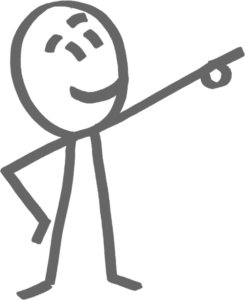

Project Manager, Information Systems
The night before his meeting, Alan decided to turn three pages of heavy text into visuals. “When you are trying to present to stakeholders, they see the final result but often unaware of the process. I felt we needed to allow the stakeholders to empathise with the human aspect of the project and show how we came to these conclusions. Telling them simply wouldn’t be enough.”
![]() The benefits of the The benefits of the Visual Coaching program were fantastic, it gave me a lot of confidence. I’d usually spend hours trying to perfect my work, but the program taught me to be more spontaneous and trust myself. I’m not making a Mona Lisa here. It’s about capturing key messages, not creating a work of art.is program were fantastic, it gave me a lot of confidence. I’d usually spend hours trying to perfect my work, but the program taught me to be more spontaneous and trust myself. I’m not making a Mona Lisa here. It’s about capturing key messages, not creating a work of art.
The benefits of the The benefits of the Visual Coaching program were fantastic, it gave me a lot of confidence. I’d usually spend hours trying to perfect my work, but the program taught me to be more spontaneous and trust myself. I’m not making a Mona Lisa here. It’s about capturing key messages, not creating a work of art.is program were fantastic, it gave me a lot of confidence. I’d usually spend hours trying to perfect my work, but the program taught me to be more spontaneous and trust myself. I’m not making a Mona Lisa here. It’s about capturing key messages, not creating a work of art.
After a trip to K-mart to get a new sketch pad, Alan decided that the story could not be shown as steps on separate pages, it needed to flow. Alan diverted his attention to a roll of plotting paper, unrolled a section on the family’s small living room floor and began to draw. For the next few hours he kept adding icons and text. Only when he took the poster to another room for colouring and unrolled it, he realised it was five meters long. “I wasn’t sure if the meeting room we booked was big enough to display it”.
His teammates, the facilitators, the clients were amazed when they saw this work. “I think I surprised myself too.” It took Alan over four hours to create his largest sketch but the result was worth it. The poster helped the team to prove the concept of work and persuade the stakeholders in the importance of the project to help secure resources and funding.
![]() That’s the power of visual facilitation.
That’s the power of visual facilitation.
“It enabled the people we were talking to, to understand not just the concept but how we came up with it. It gave the stakeholders a really good understanding of the story behind it. That’s the power of visual facilitation. You don’t have to sit there and read, you don’t have to be told, the visual is filling the gap for you.”

The ‘giving’power of Visualisation
Alan Kurrle
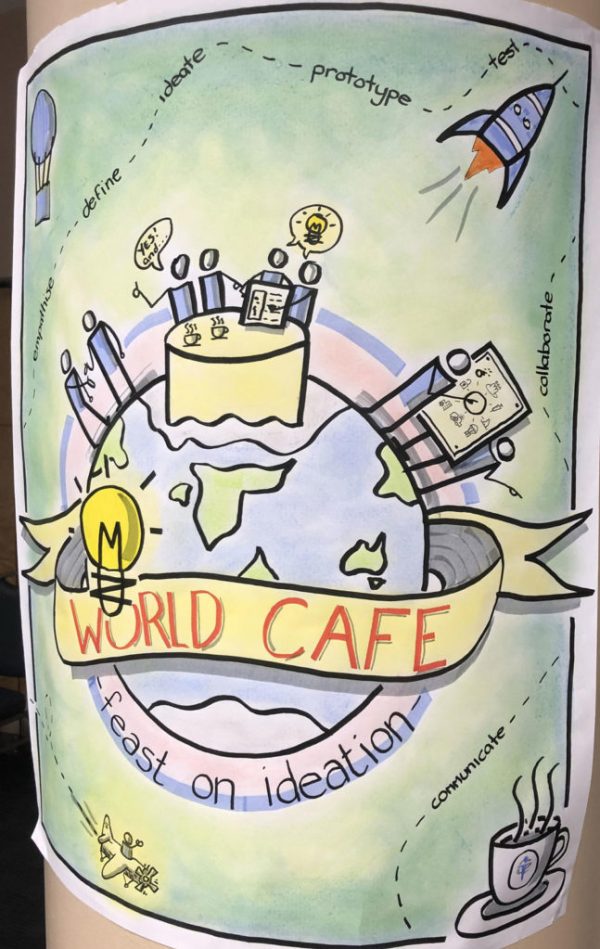
Alan feels visualisation helped humanise the project. “From my perspective, we needed to illustrate people’s feelings, to put some empathy in there. The poster captured our “why” – we are in the medical profession to care for the patient.”
Alan first came across bikablo® at one of the workshops, where he saw our Melbourne trainer John Hibble scribe. It looked impressive, and Alan wanted to give it a go. “I believe you need to keep yourself challenged in different areas. I love learning new things.”
The tagline “everyone can draw” really appealed. A visual person, Alan always felt he lacked skills to express his ideas on paper.
Alan attended two-day Bikablo® Fundamentals course in October 2018. He absolutely loved it and wanted to continue practicing but felt life got in the way. No longer feeling confident, Alan saw Visual Friends’ ad for a new, online Visual Coaching program and jumped right in.
“The benefits of the Visual Coaching program were fantastic, it gave me a lot of confidence. I’d usually spend hours trying to perfect my work, but the program taught me to be more spontaneous and trust myself. I’m not making a Mona Lisa here. It’s about capturing key messages, not creating a work of art.”
Alan found the small group of six a perfect size and the Slack channel a great way to share and learn from each other. “The program challenged us and kept us accountable.”
Alan’s five-meter poster was the result of this newly found confidence. He couldn’t be more pleased.
Alan is very passionate about his work, a big part of which is transforming hospitals into more human places. Under his management, his workplace is the second hospital in Australia to introduce a la cart room service for patients, where meals are individually cooked to order. He feels fortunate to be in a position to make a difference and happy these new skills help facilitate this.
“I’m lucky to be employed in a person-centric workplace. Our customers, the patients are right outside of our offices. It’s all about constantly improving the service we can provide, what experience we can change to actually make a positive difference to people. I want to continue to practice my skills as a part of my role. I plan to use it to visualise the strategic purpose and vision within my departments, so my team is able to be reminded of our direction every time they pass by.”
Alan is still adamant that he’s not good at drawing.
“I still maintain that I cannot draw, but what I can do is use basic shapes to create a visual. By choosing basic shapes and putting them together I can represent what I’m trying to say rather than replicate it.”

The article was written by Natalia Tsygankova. Natalia has always loved words and talking to people. She has put that passion to good use and has been sharing people’s stories in the community radio, TV and print media for the last 10 years. Natalia is also a big fan of true storytelling events and regularly volunteers at the most famous one – The Moth, interviewing the winner. You can hear her own story of moving to Australia from Russia in 1999 here. Natalia believes that everyone has a story – So what’s yours? Contact her today to share your story.



Problem solver. Product maker. Team builder. Visual Facilitator
Nuzakat admits, she’s never been a fan of plain text.
![]() I’ve always loved colour and have been interested in doing things differently, in such a way that leaves something in people’s memories. You might not remember the text on the board, but you will remember a picture. A picture will stay with you for much longer and it helps everybody to be aligned.
I’ve always loved colour and have been interested in doing things differently, in such a way that leaves something in people’s memories. You might not remember the text on the board, but you will remember a picture. A picture will stay with you for much longer and it helps everybody to be aligned.
As a developer, later a business analyst and then an iteration manager, Nuzakat found client meetings with text only bland and inefficient. “I was going to client sites trying to understand their vision and needs, and each time there would be just phrases on the board. I longed for something more.”
But Nuzakat didn’t think she was good at drawing, so she shied away from it.
Working on a project at MYOB a few years later, Nuzakat was impressed with the visualisation culture there at the time. “I’d walk around the office and see these lovely images. Everything was visually presented rather than just written on the board, so I thought I’d better learn how to do it!”
A lot of people mentioned bikablo® and Nuzakat wanted to give it a go. Unfortunately, her then employer didn’t believe it was a necessary consultant skill. “I disagreed because as a consultant you are constantly facilitating and recording information, and you’d want your clients to be aligned and leave with a great image, rather than with text you can forget. But maybe I didn’t put up a good business case.”
Nuzakat went on with her work, but the thought of upping her visualisation game wouldn’t let on. “I’d hold these meetings and attempt to draw, but I was too slow and not good at it, and people would ask me to just write it down.” She approached her management again, and again her request was rejected. She did it anyway.
Nuzakat took annual leave and spent
two days learning bikablo® technique with John Hibble in March 2018.
“I always thought I could only draw stick figures, but I found bikablo® easy to learn.”
After leaving consulting Nuzakat went to AGL, where she again began to sneak visualisation in her work. “I started by creating visualisations of user journeys and task lists. I’d put them up and once I heard a couple of comments, I began to sign my posters and include information on how to learn the technique.” Nuzakat inspired a few of her colleagues who followed suit and did training with Visual Friends.
Having come full circle, Nuzakat is now championing visualisation at MYOB, the place that inspired her to begin her visualisation journey in the first place. After a restructure, the culture in the company has changed and visualisation is no longer front and centre, something that Nuzakat is trying to turn around.
She helped promote visualisation ‘lunch and learn’ sessions and volunteered to help organise Visual Friends Meetup. Nuzakat was also an MYOB host for the first-ever Australian Visualisation Conference held last year. It was a great success and VizConf 2019 is returning to MYOB in October 2019.
“At MYOB we are always looking for new ways to do things, and a lot of people here are very visual.”
Although Nuzakat’s new role doesn’t allow her to practise visualisation daily, she is not giving up. For now, she practices by creating visual summaries of the business books she’s reading, attends the meetup and looks forward to the next Visualisation Conference. Nuzakat is also considering becoming a Visual Friends Leader, an initiative for those Visual Friends students who are passionate about the craft and want to champion it at their workplace.
Visualisation is now firmly part of her career regardless of her future roles.
![]() It’s so impactful. You see these lovely colourful images up on the wall, you can take the information in one glance and understand the message without a ton of words. I think it’s really inspiring and motivating that anyone can do this, you just have to try. It’s simple, it’s concise, it’s beautiful to look at and it’s a much better way to convey a message.
It’s so impactful. You see these lovely colourful images up on the wall, you can take the information in one glance and understand the message without a ton of words. I think it’s really inspiring and motivating that anyone can do this, you just have to try. It’s simple, it’s concise, it’s beautiful to look at and it’s a much better way to convey a message.
Do you want to start a visual revolution in your workplace? Come to one of our courses, attend a meetup or join us on slack. Keen to learn more – have a look at other stories on our website and listen to the Visual Friends radio.

The article was written by Natalia Tsygankova. Natalia has always loved words and talking to people. She has put that passion to good use and has been sharing people’s stories in the community radio, TV and print media for the last 10 years. Natalia is also a big fan of true storytelling events and regularly volunteers at the most famous one – The Moth, interviewing the winner. You can hear her own story of moving to Australia from Russia in 1999 here. Natalia believes that everyone has a story – So what’s yours? Contact her today to share your story.


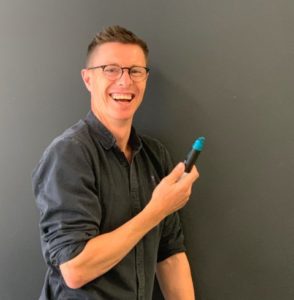
Visual Friends Trainer, Agile Coach, Bikablo® Global Trainer, Project Management Coach and Mentor from Sydney
Four months before Marc taught his first Bikablo® class, he wasn’t aware Bikablo® existed. Back then he was an experienced Project/Program Manager who was seeking a new career direction without much clarity. Bikablo® changed all that.
Today Marc is a proud and excited certified Bikablo® Visualisation Practitioner who simply can’t believe he gets paid to do what he loves. Bikablo® has revitalised his career and brought him back to what always made him happy – drawing.
Coming from a creative family, Marc had a talent for drawing but his career took him elsewhere. He missed it. Receiving a late relatives watercolour set as a gift from his mother reconnected him with his passion. “I started drawing again in my spare time. I’d take this little watercolour set with me when I travelled and made sketches.”
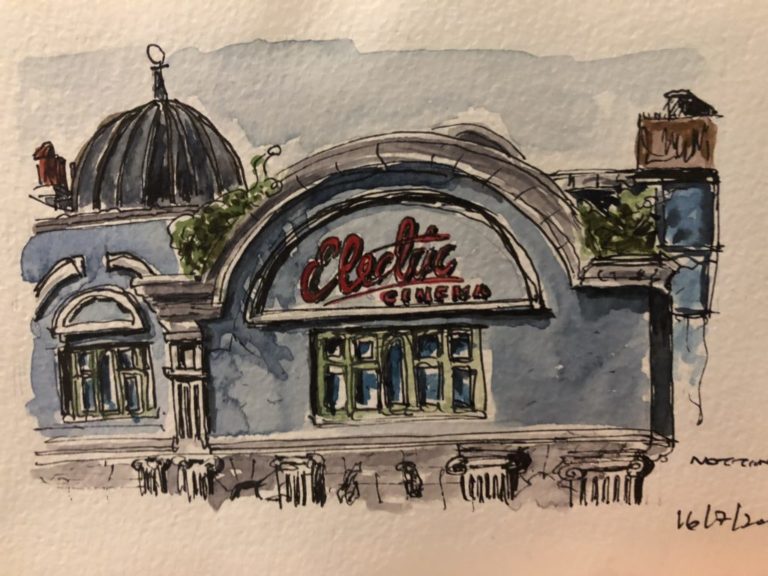
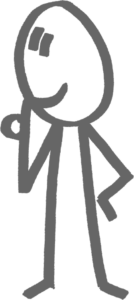
Watercolor Painting
Marc Hundleby
Marc’s roles within Project Management were not creative enough and he tried to incorporate sketches in his work. For the last few years; he’d pepper his workshops, presentations and materials with figures and icons. At one point, he decided to create illustrations in his Agile training materials. It reminded him how much he enjoyed visualisation and highlighted the lack of balance in his role. “I liked the refreshing mindset and ways of working that Agile has brought to organisations but in Waterfall project delivery there was not as much room for fun and creativity.”
A client mentioned Bikablo® and Marc was curious. As soon as he saw the images of Bikablo® posters Marc felt a strong connection to the visualisation style. A course was coming up and he enrolled immediately.
Though Marc was a little sceptical. He could draw well already so did he really need to spend two days learning the Bikablo® technique?
The course exceeded Marc’s expectations. “It showed me the structure, gave me the confidence to draw in front of people, how to strip out unnecessary detail in my sketching. Essentially, the Bikablo® technique teaches you how to simplify drawing, its not about the drawing its about the insights. While it’s still visual, creative and a lot of fun it gives you the tools to put it all it together quickly and easily. Half way through my first day I was hooked. I felt; this is it! “

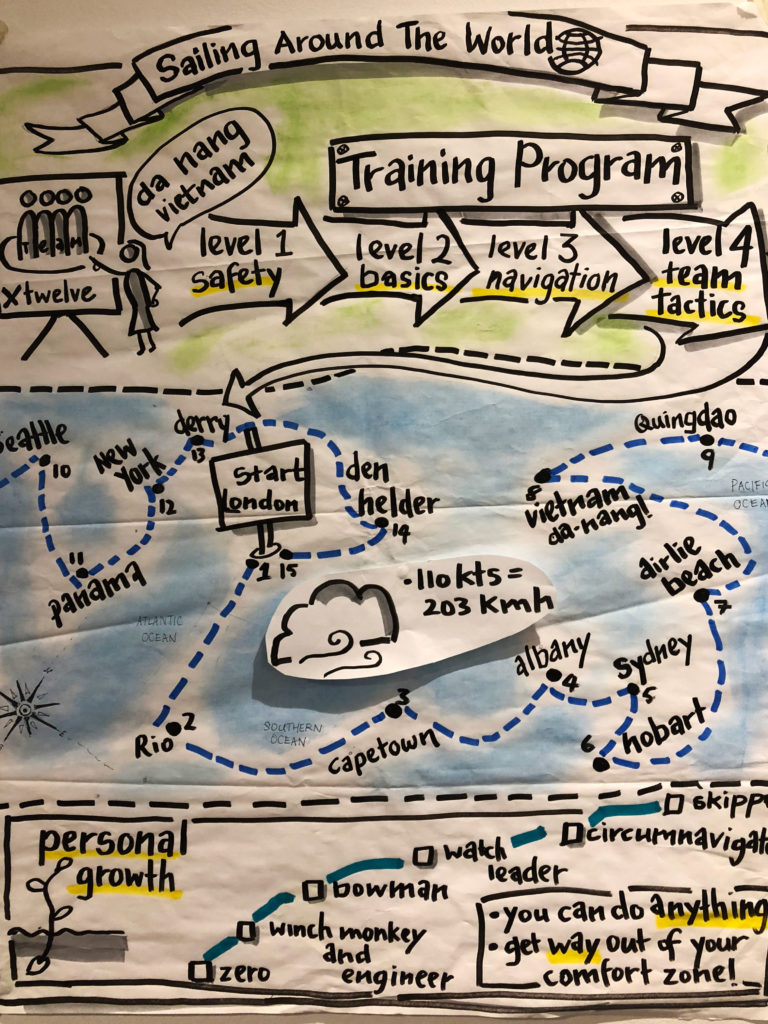
Bikablo® seemed to be exactly what Marc was looking for. “It was like the glue that was needed to pull all these different parts of my working life together – drawing, facilitation, teaching and meeting new people”.
The very next day after the course Marc was back at work putting the new skills to use in his workshops. The reaction was really positive, and the participants loved his work.
Marc knew he wanted to pursue visualisation as a new career. It was a case of lucky timing as Visual Friends was looking for new trainers. He was introduced to Marcel van Hove, the company’s co-founder, and asked to send some of this work and a visual answer to why he wanted to become a trainer. This plus a water colour sketch, Marc’s final poster from his Bikablo® class and his illustrations for the Agile training materials were sent and so began an anxious wait. In the meantime, Marc practiced like crazy and sketched daily.
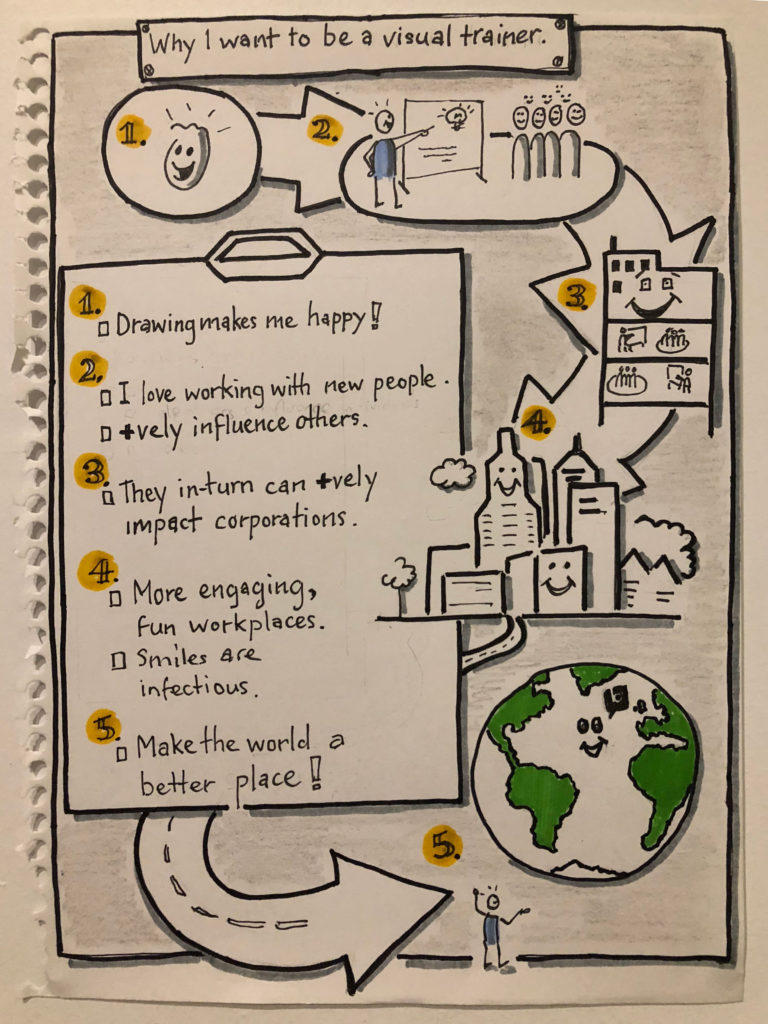

Marc Hundleby
He didn’t need to worry. His passion for drawing, his talent, his excitement about Bikablo® made him a perfect fit for Visual Friends. Within weeks, Marc was at the company’s off site and helping out during a Bikablo® course. A training in Germany followed and finally his very first class as a Visual Facilitator.
![]() I truly felt privileged to be delivering this wonderful course alongside Danny (Low) in March. There was so much joy in seeing the class pick up the technique so quickly and how thrilled they were to see the results at the end of the two days.
I truly felt privileged to be delivering this wonderful course alongside Danny (Low) in March. There was so much joy in seeing the class pick up the technique so quickly and how thrilled they were to see the results at the end of the two days.
Marc couldn’t be happier. He feels that Visual Friends has allowed him to reinstate the balance in his working life. “Instead of an occasional drawing, I’m able to inject something that makes me and others happy into my every day.”
In addition to drawing and teaching, one of the most satisfying parts of the job for Marc is helping clients overcome fear and build their confidence. “It’s so interesting to see how people think they can’t do it. It’s really rewarding to see students improve and overcome their inner critics.”
Marc believes that being a Visualisation Trainer allows him to make a positive contribution to the corporate world and more. “I can influence my clients and in turn they can positively impact corporations. A lot of corporations out there are a bit sterile, and people spend so much time at work. If you could make people smile and contribute to a more engaging and fun workplace, they’ll be a lot happier at work, out of work and eventually you can see the potential to make the world a happier place.”
If you feel like sharing the passion for drawing with Marc, want to learn a unique new skill and enrich your life and career with Bikablo® visualisation technique, book the next Sydney Bikablo® course on 11-12 June here. Who knows where it could take you! No experience required.

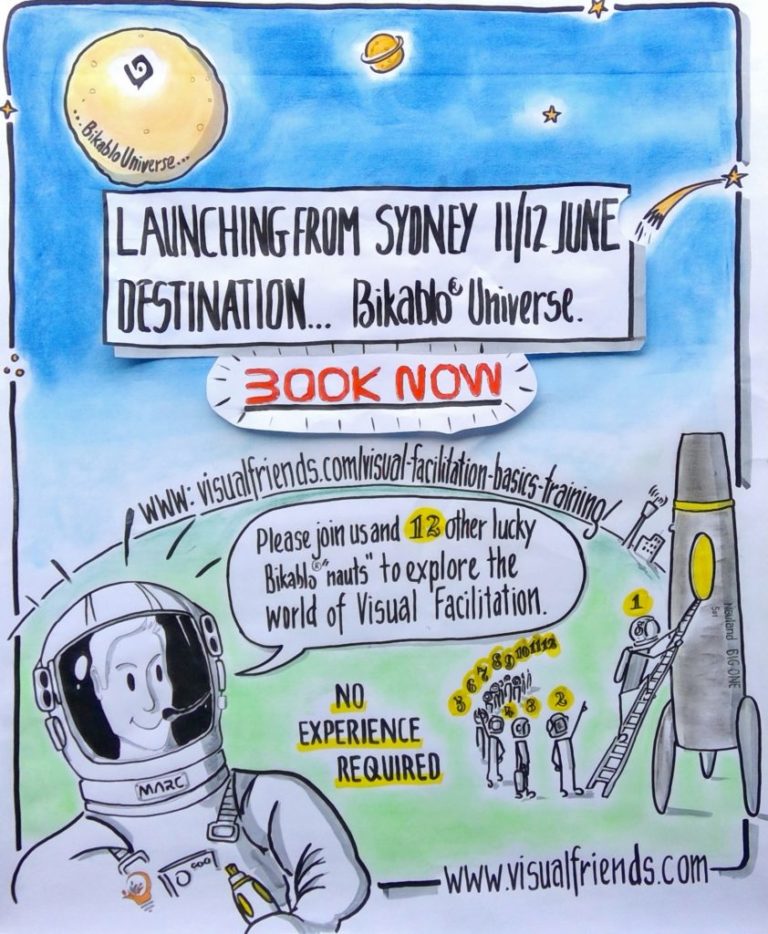

The article was written by Natalia Tsygankova. Natalia has always loved words and talking to people. She has put that passion to good use and has been sharing people’s stories in the community radio, TV and print media for the last 10 years. Natalia is also a big fan of true storytelling events and regularly volunteers at the most famous one – The Moth, interviewing the winner. You can hear her own story of moving to Australia from Russia in 1999 here. Natalia believes that everyone has a story – So what’s yours? Contact her today to share your story.



Agile Coach and Trainer/Visual Facilitator/Extended DISC Consultant AGL Energy Visual Friends two-day course, October 2014
Christiane first saw Bikablo® when meeting Marcel through her daughter’s school. She was intrigued. At the time she was looking to add something else to her toolkit and Bikablo® seemed like a perfect fit. “I felt limited in my ability to communicate complex concepts, and I also didn’t feel like I was having a lot of fun in my role.” Christiane attended one of the first Bikablo® courses offered in Melbourne, back in 2014.
Not only did Christiane learn a new skill that allowed her to inject some fun into her every day work, the course changed the trajectory of her career, allowed her to meet some amazing people, be part of unique events and play a role in changing the company culture at her workplace.
Christiane’s biggest insight from the Visual Friends course was how easy it was to learn. “It’s a technique that anyone can pick up. If you can draw a stick, you can draw Bikablo®.”
![]() “Visualisation helps break down communication barriers, removes ego and takes away a lot of tension and bias. It makes people really happy. Drawing and playing with colour reminds us how to be free, creative and unburdened, it helps us reconnect to ourselves and be present in the moment.”
“Visualisation helps break down communication barriers, removes ego and takes away a lot of tension and bias. It makes people really happy. Drawing and playing with colour reminds us how to be free, creative and unburdened, it helps us reconnect to ourselves and be present in the moment.”
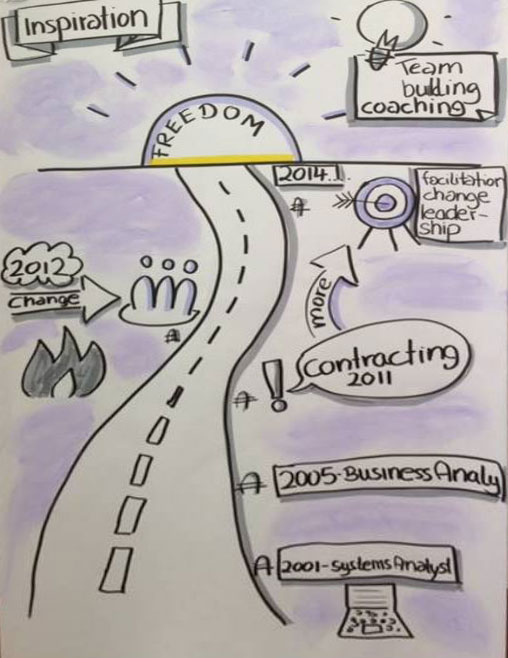

Visual Friends training final poster
Christiane Anderson
She began to put her new skill to use immediately. Christiane would ask teams to allow her to visually record their meetings or capture retrospectives. Her hand drawn posters began to appear all over the office. “I got a lot of really positive feedback. People felt the drawings added a different dimension to what was being said and helped them remember the key messages. At first the leaders were concerned scribing would be distracting, but instead it helped people focus on what was communicated.
For the next four years, Christiane worked with Marcel van Hove, Visual Friends Co-founder, scribing for various conferences, breakfast events and even international speakers.”It gave me an opportunity to meet some amazing people and have access to events I would not have otherwise had access to.” A particular highlight was scribing for Barry O’Reilly, the author of Unlearn and Lean Enterprise. He used her drawings in his marketing and training materials.
Christiane also did lots of drawing at work and began to play a role of a visual coach helping teams with visual templates, metaphors and concepts.
Not only did Christiane learn a new skill that allowed her to inject some fun into her every day work, the course changed the trajectory of her career, allowed her to meet some amazing people, be part of unique events and play a role in changing the company culture at her workplace.
Christiane’s biggest insight from the Visual Friends course was how easy it was to learn. “It’s a technique that anyone can pick up. If you can draw a stick, you can draw Bikablo®.”

Barry O’Reilly in front of Christiane’s work
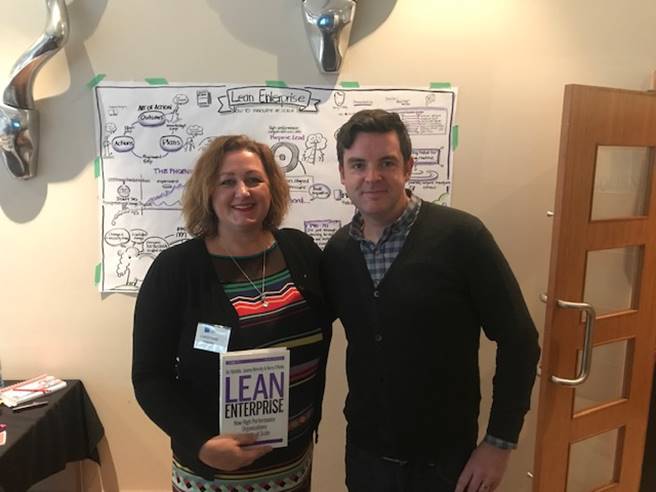
For the next four years, Christiane worked with Marcel van Hove, Visual Friends Co-founder, scribing for various conferences, breakfast events and even international speakers.”It gave me an opportunity to meet some amazing people and have access to events I would not have otherwise had access to.” A particular highlight was scribing for Barry O’Reilly, the author of Unlearn and Lean Enterprise. He used her drawings in his marketing and training materials.
Christiane also did lots of drawing at work and began to play a role of a visual coach helping teams with visual templates, metaphors and concepts.
Not only did Christiane learn a new skill that allowed her to inject some fun into her every day work, the course changed the trajectory of her career, allowed her to meet some amazing people, be part of unique events and play a role in changing the company culture at her workplace.
Christiane’s biggest insight from the Visual Friends course was how easy it was to learn. “It’s a technique that anyone can pick up. If you can draw a stick, you can draw Bikablo®.”

The article was written by Natalia Tsygankova. Natalia has always loved words and talking to people. She has put that passion to good use and has been sharing people’s stories in the community radio, TV and print media for the last 10 years. Natalia is also a big fan of true storytelling events and regularly volunteers at the most famous one – The Moth, interviewing the winner. You can hear her own story of moving to Australia from Russia in 1999 here. Natalia believes that everyone has a story – So what’s yours? Contact her today to share your story.



Business Agility / Transformation Coach
![]() As a facilitator, I consider it really important to capture and present the participants’ content in a way that’s valuable to them. There are many workshops out there, but how you are going to make yours different, how will you make people’s content and ideas memorable? Through a better workshop, you get a better outcome so you can increase productivity, energy and communication in an organisation.
As a facilitator, I consider it really important to capture and present the participants’ content in a way that’s valuable to them. There are many workshops out there, but how you are going to make yours different, how will you make people’s content and ideas memorable? Through a better workshop, you get a better outcome so you can increase productivity, energy and communication in an organisation.
We could have almost replaced Biunca’s story with her brilliant poster. She created it in response to our interview request to talk about the role of visualisation in her work. “I wanted to get a bit of perspective down on paper about why I thought visualisation was important. Because at the end of the day, what better way to talk about the visualisation than to visualise it.”
Biunca came across Visual Friends last year and did both the Basic and Advanced Visual Storytelling course. But her visualisation journey started well before that.
She always enjoyed drawing. “I was probably always the kid in class who’d prefer to draw in the corner, rather doing math or writing. “
As Biunca moved into her working career the skill proved to be useful. “I found it was often easier to sketch out the problem and talk to people through the sketch to get a good understanding of the issue.”
As Biunca’s career progressed from facilitation to Agile ways of working, her visualisation skills continued to change too. Sketching moved from a notepad onto a wall, Biunca began to use Sketchnoting and even scribed for a few conferences. “I realised there’s more to learn about visualising effectively. I was also wondering if I was really maximising the technique.”
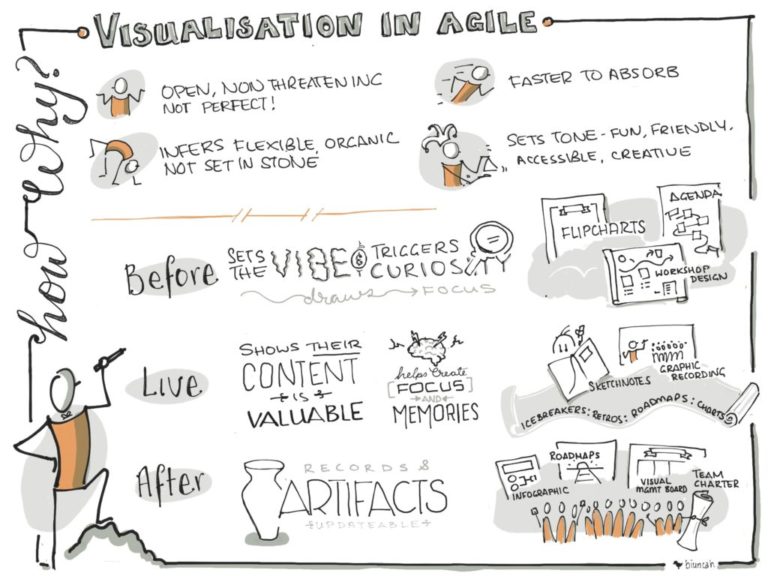

Visualisation in Agile
Biunca Hooper
Enter Visual Friends.
One of the personal challenges was visualising effectively in a larger format. Biunca thought sketching on A4/A5 didn’t present a lot of risks and wanted to challenge herself. “I wanted to understand how to fill a big flipchart, how to balance the real estate on a page and quickly add hand-drawn images. Those things I found really valuable.”
Learning about the best way to hold a marker, how to get ink consistency to form your pen and how to streamline your poster handwriting was unexpected but welcome knowledge. “I often get compliments now about my handwriting on posters, the course really improved my technique.”
To further refine her skills Biunca followed up the bikablo® fundamentals class with the Advanced course.
![]() It provided a different perspective – bringing visualisation to life through storytelling, a powerful tool from the facilitation perspective.
It provided a different perspective – bringing visualisation to life through storytelling, a powerful tool from the facilitation perspective.
Biunca believes the course changed her visualisation style and allowed her to use the skill in her work with more confidence. “If you looked at the before and after photos my work, you’d definitely see the difference in style, and probably the number of flipcharts and visualisations that I was doing increased as well.”
The Visual Friends course also allowed Biunca to strengthen her facilitation and Agile coaching tool kit. “I guess what the course enabled me to do is to really apply my skills in a much broader range of workshopping activities.”
Biunca runs workshops all the time and uses visualisation on a daily basis. She truly believes it contributes to a better-quality outcome. “As a facilitator, I consider it really important to capture and present the participants’ content in a way that’s valuable to them. There are many workshops out there, but how are you going to make yours different, how will you make people’s content and ideas memorable? Through a better workshop, you get a better outcome so you can increase productivity, energy and communication in an organisation.”
Creating value for her clients is one of the most satisfying parts of Biunca’s work, and visualisation really supports that. “I love seeing participants excited about the way their content has been captured. It’s a takeaway item that people can keep or share with others, something they are proud of. For me, it’s one of the most important things.”
Biunca believes visualisation supports culture change in an organisation. “People tend to interact in front of visualised content, you have more conversations, it creates more energy. If you go from a very stark environment with very few posters or post-it notes around to a visual way of working where there are containers and objects for people to put content into, really awesome sketches of workshops showing progress and highlighting things, it indicates a real change in the style of communication.”
Biunca would love to see more organisations take on visual ways of working as the benefits speak for themselves. “It’s around encouraging everyone to visualise because I think people get so caught up in trying to communicate through words alone, through e-mail and ineffective meetings. How do we bring in visualisation as a key communication and collaboration tool, not a sideline or executable outcome? How do we do it by design? Literally.”

The article was written by Natalia Tsygankova. Natalia has always loved words and talking to people. She has put that passion to good use and has been sharing people’s stories in the community radio, TV and print media for the last 10 years. Natalia is also a big fan of true storytelling events and regularly volunteers at the most famous one – The Moth, interviewing the winner. You can hear her own story of moving to Australia from Russia in 1999 here. Natalia believes that everyone has a story – So what’s yours? Contact her today to share your story.

Zhi is an Agile Coach at Teamworx, an Agile Coaching and Training consultancy based in Auckland. A big part of his work is to help teams increase their flow through visualising their work. He works at Mercury, an Energy company in New Zealand.
Like many Visual Friends students, Zhi didn’t grow up loving drawing. “As a kid, I was never good at Art. In fact, I used to get D’s or C’s at Art classes.” Now Zhi is using visualisation techniques daily and even coaching others. It’s one of the most powerful tools in his Agile Coach toolkit.
Zhi saw Bikablo® in action by accident. At a strategy offsite he was attending, the scribe happened to be a Bikablo® practitioner. The simple and striking visual language piqued Zhi’s interest. At the time, he was already practising Sketchnoting, which is essentially processing information, distilling it, then expressing the concepts using a combination of simple imagery and visuals. “People seemed to enjoy meetings with sketching and were more involved.” However, seeing the Bikablo technique opened doorways for taking his practice further. Zhi was really keen to learn this visualisation language made such an impression. In 2018 there was an opportunity to attend a two-day Visual Friends course in Auckland, and Zhi jumped right in.
The self-taught technique of Sketchnoting had given Zhi a foundation for visual thinking. “The two days with Visual Friends allowed me to apply that background knowledge and sharpen my drawing technique. It was fantastic to have two days of practical experience.” Zhi found Bikablo® accessible and impactful at the same time. “One of the main principles was to simplify things to the max, and I learnt to use simple lines and shapes as opposed to stressing out about creating a perfect picture.” Zhi also credits the course with increasing his confidence to sketch in front of a group and facilitate a conversation. “People often comment on the quality of the drawings, they love it.”
New skills lead to new career opportunities. Zhi ran two major graphic recording sessions at his workplace. One was for a Finance team which invited him to scribe at their strategy off-site after seeing his work. “The typical stereotype of accountants is that they “by-the-book” and focused on numbers, instead of conversations. I felt that was not true when I started drawing and explaining the purpose of visualisation to the team. When they understood how useful it is to summarise key points and present them as a picture, when they saw graphic recording in action, they got really interested in the visual way of working.”
Video of the graphic recording at the Finance Offsite:

That experience was a special one for Zhi. “My work as an Agile coach is to teach people new ways of collaborating, new ways of visualising their work and how to have really good discussions. Visualisation has enabled me to do that outside of IT which has been a real highlight. “
Zhi’s most proud moment so far has been using the skills learnt through Visual Friends to record the history of his company, Mercury, at a recent event. He was invited to scribe at an offsite where the discussion evolved around the past, present and future of the geothermal fields (Mercury is an energy company and geothermal fields are one of the energy sources). Two long days, 16 hours of graphic recording and 20 meters of paper later, the scroll was complete.
“It was amazing to record our journey and put it to pictures. Ours is the company that really values NZ heritage and to be able to represent the history of the place, to see people being so engaged in the conversation was such an honour for me.” Zhi’s recording was laminated and sent to all of Mercury’s geothermal field sites around New Zealand. “We displayed the large sketches in the offices to make it easier to explain what each Geothermal field is about. It’s just amazing.” Zhi believes his visualisation contribution is enhancing the way teams work at his workplace. “My scribing for the Finance department is a good example of how visual culture is slowly becoming not just an Agile and IT thing. Lots of other departments have become interested in visual ways of working.”
Zhi is confident using visualisation is going to enhance the way organisations communicate. “Visualisation makes the connection so much richer as opposed to talking to someone or reading a message off a list. People perceive the message better. You can have a better-quality conversation.” You can find out more about Zhi’s work here.

The article was written by Natalia Tsygankova. Natalia has always loved words and talking to people. She has put that passion to good use and has been sharing people’s stories in the community radio, TV and print media for the last 10 years. Natalia is also a big fan of true storytelling events and regularly volunteers at the most famous one – The Moth, interviewing the winner. You can hear her own story of moving to Australia from Russia in 1999 here. Natalia believes that everyone has a story – So what’s yours? Contact her today to share your story.


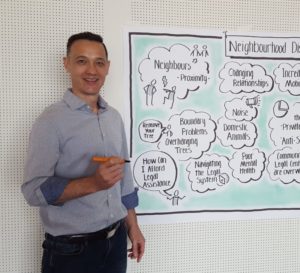
Trainer & Partner at Visual Friends
Let me introduce to you Danny Low. Danny is not only a bikablo® trainer and partner at the Visual Friends. He is also a very good friend of mine and in many ways, we are very similar. We talk a bit about that but we forgot to talk about one great story. So in the early days when I met Danny, he told me that he will take time off and travel with his family around the world.
He told me that he would like to pass on some of the experiences he and his wife Anna had and to show the kids the world. With that, we pretty much hit the core DNA of Danny. He likes to pass on his life experience to others – not only to his kids but also to his students at the Visual Friends. He likes to help others and is a great mate that everyone would like to have as a friend. We follow his personal journey, learn how to visualise legal contracts, hear about project management, agile coaching and how he became part of the Visual Friends. For me, Danny’s story is another great example of what can happen in life when you follow your passion and make a couple of choices at the right time. Please welcome our lawyer and Kung-Fu master Danny Low from Brisbane.

Marcel combines agile team coaching with visual thinking. Marcel believes that a group of people drawing together on a whiteboard can change the world. He loves high-performing teams and therefore coaches teams every day.

Do you remember the time when Apple was founded or maybe have seen the movie ‘Pirates of Silicon Valley’? Until I met Dean, I never had met a person who worked at Apple at that time when the first Macintosh and with that the first graphical user Interface (GUI) was released to the world.
Dean knew that someone had to explain this new GUI-thing and therefore probably was one of the first trainers on the planet to teach how to use a GUI.
What strikes me when talking to Dean is his wide range of professional skills. You might know that we all learn by using different modalities. Some people prefer to access new information by reading or learn better by writing it down. Others need to hear it or visualise ideas. Different people again like to touch things and have a quick understanding when doing something with their hands. Through the years we find our preferred way of learning and develop it as your core skill. Dean is different here.
Dean is different – I haven’t met a person who has such a high experience in all those different modalities. He is not only a visual problem solver & design thinker but also an educated opera singer and music composer.
Additionally, he believes in the power of thinking with our hands and therefore is a facilitator for LEGO SERIOUS PLAY where you use LEGO bricks to coach people by building something with their hands. I am delighted to introduce to you Dean Meyer from New York.

Marcel combines agile team coaching with visual thinking. Marcel believes that a group of people drawing together on a whiteboard can change the world. He loves high-performing teams and therefore coaches teams every day.

As an agile & visual coach, I am still humbled about the positive impact our visualisation methods make on knowledge workers.
The bikablo technique features a fast, unique learning experience that works in your office location and has a great impact – the Symbol Safari. So what is the Symbol Safari?
The Symbol Safari is an activity that engages a team to create incrementally build a complex visual metaphor for a specific theme.
It is a great introduction with working with a marker and also using visuals in a team to create meaning out of complexity, with the help of bikablo® icons.
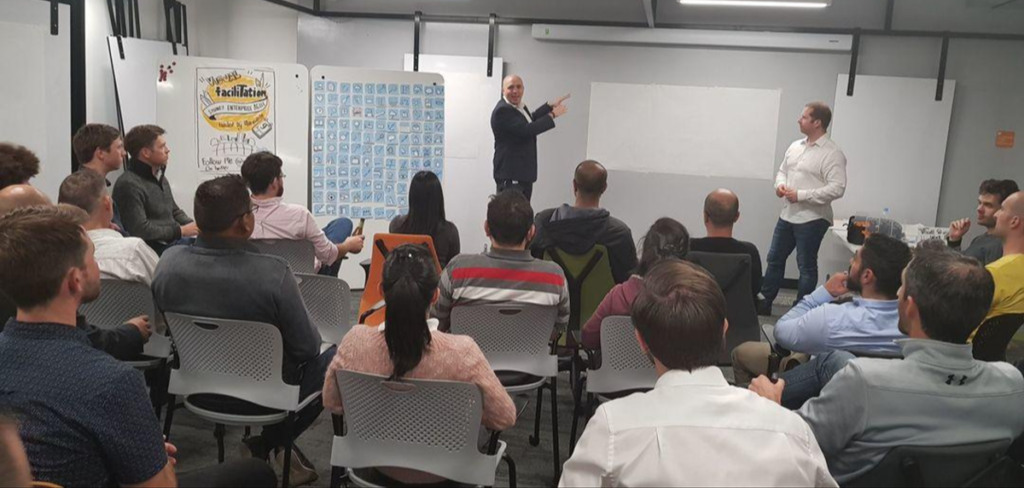
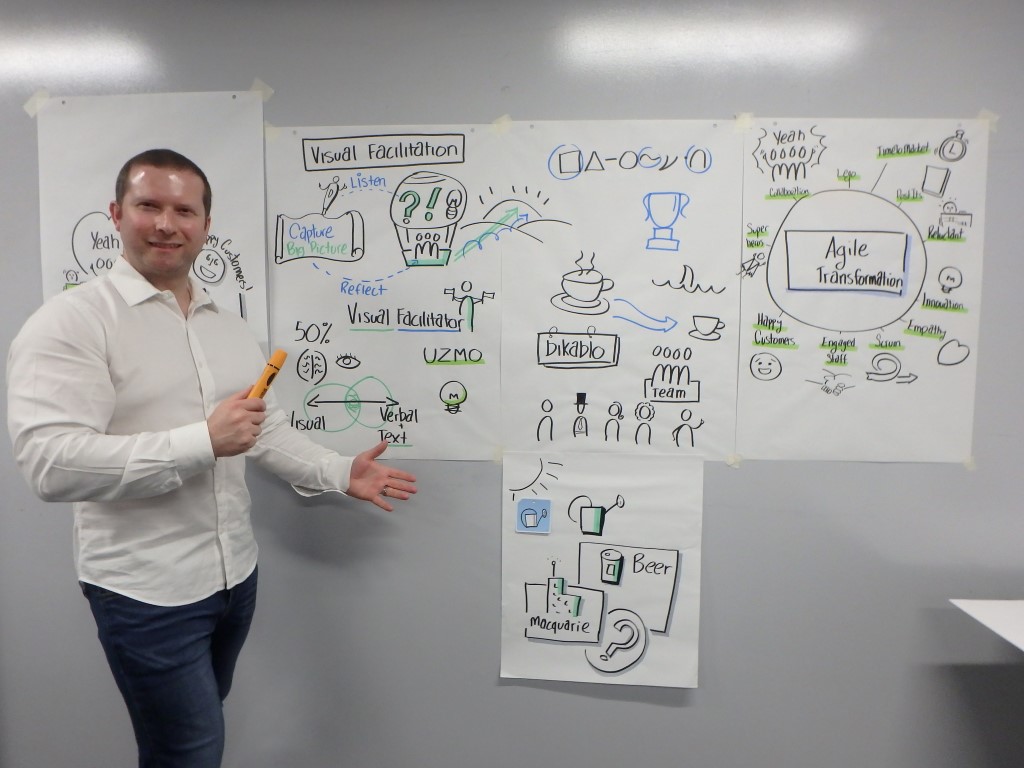
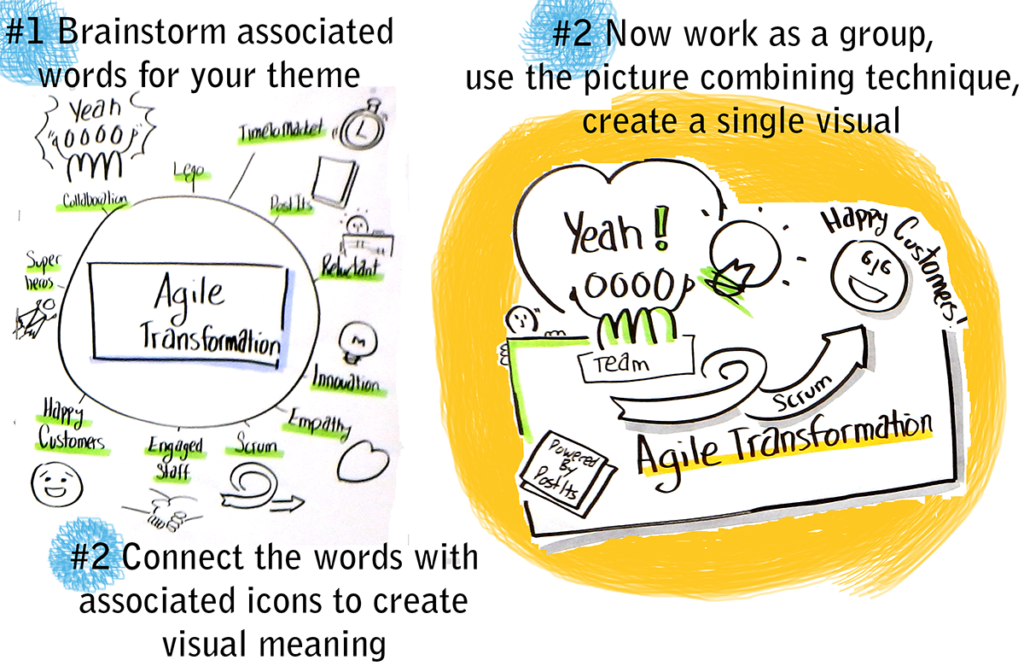
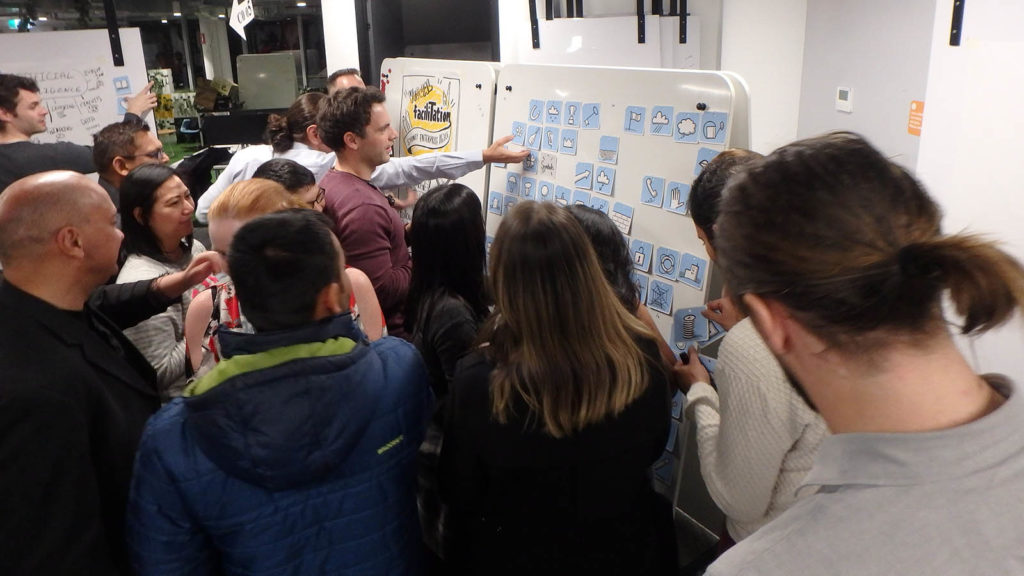
A Symbol Safari workshop is a great introduction to visual thinking and learning to draw with bikablo methods.
Our training team offers bookings for this event. We bring all equipment, all we need is a room, with a few whiteboards and lots of curious minds.
Workshop Duration ~ 2hrs
Workshop Investment: $1080.00 (plus GST)
Discount: The amount will be deducted as a discount when ordering an in-house training within in 6 month.

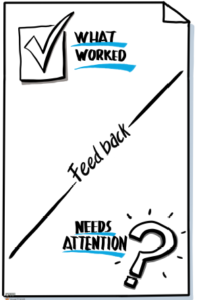
You are a facilitator. You are busy. A workshop is coming. Sounds familiar? Well Visual Friends are here to help.
As a facilitator, after you have designed your workshop you may consider how visualisation can support your event. Visual Friends are releasing a set of visual posters in the bikablo style that could help.
These are A0 size layouts that can be pre-printed to save you time to focus on content over layout.
We’d love to hear your feedback and perhaps any poster styles that you’d like to request.
All the best, the Visual Friends Team.

A simple frame holds the information together.
Just one box more. A headline and a simple frame holds around your text holds your insights together. Download


Great poster template to summarise your next brain storming. By the way, let everyone think alone first then consolidate together. This creates more diversity. Download
Just add the topic you investigate together on the top and hand out post-it to cover the question mark! Have fun together. Download


Use this template to look back or plan the next actions ahead. Use the SMART (Simple, Measurable, Achievable, Relevant and Time based) writing for clear defined actions. Download
Ask your team for feedback after the workshop. Use Post-its and make them write! Place this flip chart at the exit of your workshop so that people can leave anonym feedback if they choose to. Download
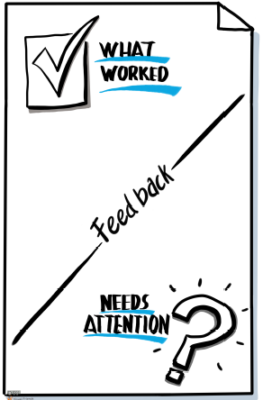

Marcel combines agile team coaching with visual thinking. Marcel believes that a group of people drawing together on a whiteboard can change the world. He loves high-performing teams and therefore coaches teams every day.

